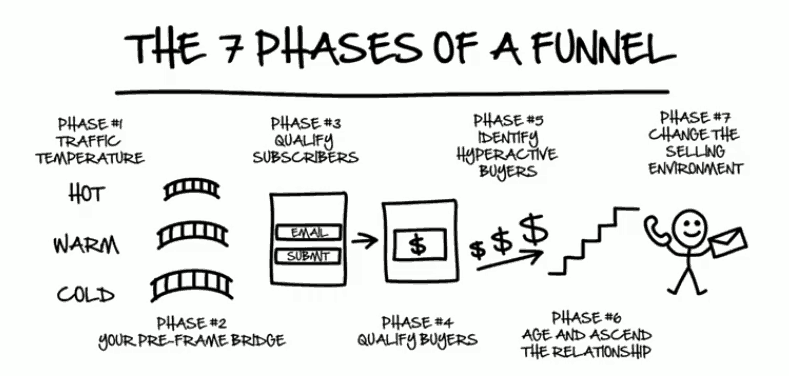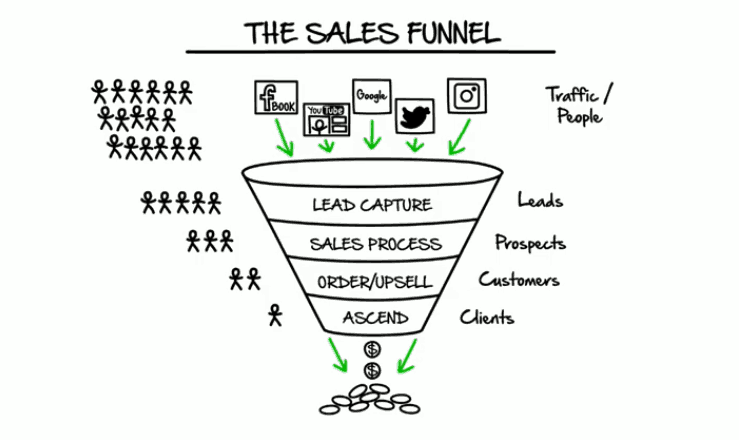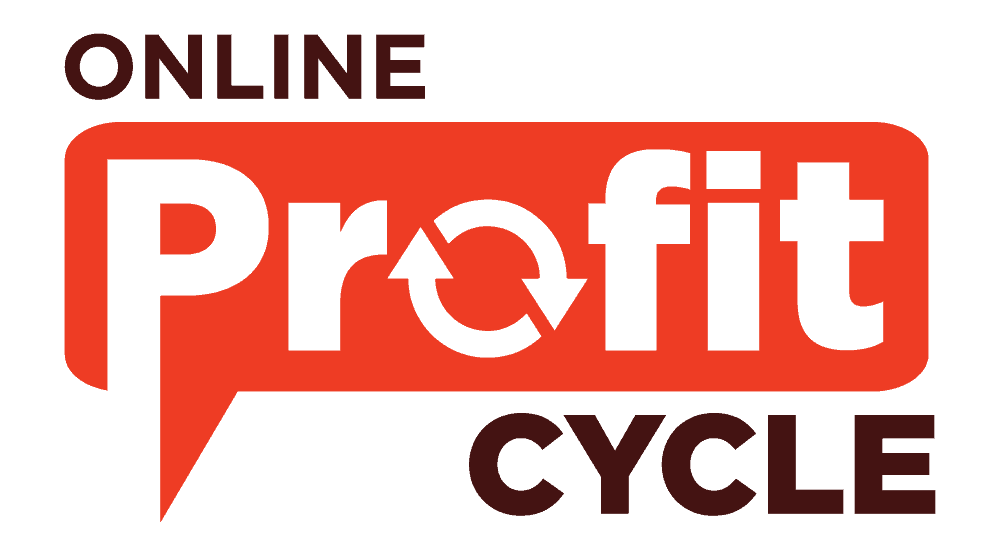The 7 Sales Funnel Stages To Understand How It Works
Sales funnels have become a popular term among entrepreneurs doing business online. That’s because each stage in the funnel helps the business drive more leads and sales.
A sales funnel consists of several stages that take a person through the process of being a prospect to becoming a customer. Each step in the funnel contributes to making you sales and increasing your profits.
You see, a sales funnel is more than just a web page with some sales copy on it. To maximize leads and sales, you need to utilize all of the right stages in the sales funnel.
Overall there are 7 stages or phases that need to be included when creating a sales funnel for your business. If you combine them all in the right way, there will be no doubt that you could create a highly effective way of selling your products online.
Disclaimer: This article may contain affiliate links where I may receive a small commission at no extra cost to you if you decide to purchase a paid plan. For more information read my Disclosure.
What Are The Stages Of A Sale Funnel?
Here you have a complete overview of every stage in a sales funnel. There are 7 stages that take people through your entire funnel. From scrolling down Facebook to becoming your hardcore customer.

1. Traffic Temperature
Generating traffic and marketing your business is the first stage in the sales funnel. Here you are building awareness of your product to potential customers.
This step comes at number one because every business needs traffic to generate leads and sales. This applies to both online- and offline businesses.
What’s more important than just generating traffic to your landing pages and sales funnels, is to generate the RIGHT KIND OF TRAFFIC. Answer this question:
Where are you getting your traffic from?
This is truly important and maybe the most crucial point of the sales funnel. Because if you don’t manage to generate the right kind of traffic, you’ll have a hard time converting your visitors into sales.
What you need to know about the first stage in the sales funnel is that there are three types of traffic: hot, warm and cold.
Traffic Temperature Explained
- Hot traffic: Hot traffic is the highest converting traffic, they’re aware of who you are and the product you’re selling. They like you, and because of that, they’re most likely to buy your stuff. Hot traffic can be previously customers of yours or be on your email list. It is easy to convert existing customers.
- Warm traffic: These are people who are in your industry, but they don’t know you yet. They might have a problem that you can solve with your product or service. All you need to do is to get in front of their eyes and present your offer. You might target your warm audience with Facebook, YouTube, or Google ads.
- Cold traffic: These are people who don’t know who you are and they’re not in your industry. This is the hardest type of traffic to convert into customers. Normally I would avoid spending too much money trying to get cold traffic into my funnels.
When you’re building an entrance-point for your funnel, you need to adapt it to your traffic temperature. Are you building it for a hot audience that knows who you are or a cold audience that’s not in your industry? It makes a lot of sense if you think about it.
If you need to learn more about how you generate hot traffic with people craving to buy from you, I highly recommend you read the FREE Book Traffic Secrets by Russell Brunson.
2. The Pre-Frame Bridge
The pre-frame bridge is the second stage in the sales funnel. This is also a very important phase because you’re preparing your visitors on what to expect once they land on your opt-in page.
If you skip this step and send traffic straight to your funnel without pre-framing your offer, many of them will have no idea of what’s going on. Remember this:
The 1st rule in direct respond marketing is: A confused mind says always no.
If your visitors don’t know what’s going on, they’ll most likely leave. And that is the last thing you want when spending a ton of money on ads.
How do you pre-frame your offer?
The goal with the pre-frame bridge is to increase interest in your product and prepare people for what comes next. It’s all about getting your traffic in the right mindset before entering your funnel.
Here are two examples of how you can pre-frame your offer. One of them will work and the other won’t!
Scenario: You share a post on Facebook about a weight loss program you just finished.
Example 1. In the first post you say ”I joined this weight loss program and it didn’t really work out at all. After six weeks I haven’t achieved the transformation I hoped for, but maybe it will work for you. If you want to check it out here’s the link.”
Example 2. In the second post, you say ”WOW, can’t believe how fit I’ve become after joining this weight loss program. I didn’t think I could do it, but with the help from some amazing instructors, I’ve really turned my health around. I highly recommend all of you try it yourself. It’s a life-changer. Click here to get a free call with one of the trainers.”
You might get traffic from both posts, but which of them do you think will send you your future customers? My bet is the people coming from post number two.
When the pre-frame bridge is done right you’ll generate more qualified traffic and possibly receive higher conversion rates. To learn how you can create the perfect pre-frame bridge I recommend you take a look at DotCom Secrets.
3. Qualify Leads
Qualifying leads is the third sales funnel stage.
After your prospects click on your ad or social post, they land on the first page in your funnel, the squeeze page. Your only goal here is to trade a lead magnet with their contact information like an email address or a phone number.
Now you’ll start growing your email list with qualified leads.
You can then follow-up with your leads through email and keep building your relationship. Then you can use the trust you gain to keep promoting products in the future with automated email sequences .
This is an important stage in the sales funnel process because your traffic makes their first commitment to you and becomes leads. After they’ve opted in on the squeeze page they’ve made their first conversion.
It’s a sign that they’re beginning to trust you and are more likely to purchase your product.
Because some people will never give you their email, and those people will most likely never buy from you either.
How To Generate Quality Leads
As the stage or phase says, you’re going to qualify leads. This is done with a very simple landing page with the only intent to collect an email address.
Here are some things to remember:
- Create a lead magnet that you can trade for contact information. This lead magnet could be a checklist, video training, or ebook, it MUST be related to the product you’re selling in the next funnel stage.
- Keep the opt-in page simple! Remember, your only goal is to give them something for free in exchange for an email address. You don’t have to start selling anything on this page.
- Have a clear call to action. A confused mind says always no. If the prospect doesn’t know what to do next they’ll most likely leave the page.
Once your prospects opt-in they become qualified leads, then they’re sent to the next sales funnel stage: the sales page.
4. Qualify Buyers
The fourth sales funnel stage is to qualify byers.
Your qualified leads have just landed on the sales page and this is when they’re most likely to buy, and of course, we have to take advantage of that.
To maximize conversions on the sales page we often use a ”trip wire” or a ”self-liquidating offer” which is a low-cost offer that is a complete no-brainer. It could be as low as $5-$7 because we want to convert the maximum amount of leads into customers right of the gate.
The goal here is not to make huge profits, but to make just enough to cover the ad spend. The big revenue offers come further down the sales funnel.
Once your qualified leads have entered their billing information and purchased your low-ticket front-end offer, they’ve become your qualified buyers.
But that is not even the best part!
With a highly intelligent sales funnel builder like Clickfunnels, their billing information is automatically saved. This will be used in the next sales funnel stage on the upsell-, down sale- and one-time-offer pages.
Now it’s time to make some bucks.
5. Identify Hyperactive Buyers
The next stage in the sales funnel process is to identify the hyperactive buyers, but what’s that? Hyperactive buyers are people who purchase several things at once.
Example: You go to the store to buy a specific product, but on your way out you find more products that you end up buying. That’s a hyperactive buyer.
Now your qualified buyers have entered the back-end of your funnel. This is where most of the profits are made.
This part of the funnel is where you have the One Time Offers, Upsells, and Downsells with products related to your main offer. The hyperactive buyers will then use this opportunity to buy more of your products.
This stage of the sales funnel is used to increase the average cart value of every customer that enters your funnel. It is exactly what differentiates a sales funnel from a normal website.
The Upsell and Downsell pages can easily be created inside Clickfunnels, which is one of the most popular all-in-one marketing platforms in the world. With Clickfunnels remembering their billing information from the front-end offer, the hyperactive buyers only need to click one button and their credit card will be charged.
This is how the big companies make their money and are able to outspend their competitors. They simply just make more from each customer than anyone else.
If you need to learn how to set up a funnel like this inside Clickfunnels to skyrocket your earnings then jump on the One Funnel Away Challenge. It is a low-ticket sales funnel training from the best in the industry.
6. Age and Ascend The Relationship
In stage 6 of the sales funnel your goal is to age and ascend the relationship with your customers.
If you’ve read the book DotComSecrets, you’re familiar with the value ladder. The concept behind the value ladder is to promote more high-end products as the relationship grows between you and your customers.
This stage takes place after your customers have left your sales funnel. In the following weeks, months and years you must keep providing value to your following through email campaigns and other social platforms.
Because the reality is, a percentage of your existing customers want more value from you. Remember this:
People will keep buying from you, until you stop selling to them or offend them.
Russell Brunson
When the relationship has become strong enough you can start offering high-ticket coaching or exclusive events. One thing to remember when you approach the top part of your value ladder is to change the selling environment. This brings us to sales funnel stage number 7.
7. Change The Selling Environment
Sales funnel stage number seven is all about changing the selling environment.
If you want to succeed in selling high-ticket offers you need to connect with your audience on a deeper level. This can be done through live events, webinars, 1-on-1 coaching or over the phone etc.
In the end, it is just another way of closing sales and growing your business. If you can provide the best customer service along with world-class products you’re already there.
An example of changing the selling environment is Clickfunnels, the worlds leading sales funnel builder.
They have multiple low-end products like books and free training that gets people to enter their funnels. With high converting sales funnels, many of those prospects become hardcore customers.
Some of the ways Clickfunnels are changing the selling environment are by hosting live events like Funnel Hacking Live, offering 1-on-1 coaching and selling over the phone etc.
This strategy is growing their fanbase rapidly and converts a lot of people into using their software.
The strategy works! so, how can you change the selling environment in your business?
The Sales Funnel Stages Summarized
There you have every stage of the sales funnel. An entire process that takes your traffic from being new prospects to hardcore customers. Each stage of the funnel has its own purpose and should not be skipped.
If you take a look at the sales funnel in a greater view, you can see that process is divided into mainly three parts:
- Marketing (Stage 1 and 2). This is the part where you are generating traffic and pre-framing your idea.
- Front-End Sales Process (Stage 3 – 5). In this section your prospects arrives at the entrance point of your sales funnel. They will be guided through the process and end up as customers.
- Back-End Sales Process (Stage 6 and 7). In the last phase of the sales process you ascend the relationship with your existing customers and offer them more products as time goes on.
There you have the entire sales process and each stage explained in simple words. If you want a deeper understanding of sales funnels, the video below will be to great help.
If you want to know how this exact funnel strategy has helped businesses grow from startup to million-dollar companies in just months, then watch this FREE presentation of The Secret Funnel Strategy by Russell Brunson.
What Is A Sales Funnel and How Does It Work?
A sales funnel is multiple web pages put together in a specific order to maximize the overall cart value of each person that clicks your ad. It works as shown in the image below:

You start with the traffic and sends them to a landing page where you collect email addresses. Then your leads are sent to a sales page where they are presented with a super high-value offer that they can’t turn down. When they’ve shown commitment and purchased your front-end offer they’re sent further down the funnel. Now they land at the upsell, and down sale pages that offer them other related products at different price points.
The goal of a sales funnel is to break even on ad spend, automate the sales process and increase the average cart value.
If you want to build your sales funnel on a legit platform you can go to Clickfunnels and start your free trial. There you’ll be able to create any kind of web pages that your business needs. You can also use over 100 free templates.
Conclusion
There you have the 7 sales funnel stages to maximize revenue for your business. Used together they can turn your business around and skyrocket your sales.
Here’s a short recap of the steps in a sales funnel:
- Traffic Temperature: Focus on generating hot traffic!
- Pre-frame Bridge: Get your visitors in the right mindset so they know what to expect once they land on your funnel.
- Qualify Leads: Generate leads through an opt-in page.
- Qualify Byers: Sell a low-ticket offer on the front-end that is a no-brainer.
- Identify Hyperactive Byers: Upsell your customers with more expensive products.
- Age and Ascend The Relationship: Build relationships with your customers and keep adding value through email campaigns.
- Change The Selling Environment: Host live events or get on the phone to sell your high ticket offers.
Hope you learned the stages of a sales funnel and how they can work for you. If you found the article helpful, please share it with your entrepreneurial friends, and have an amazing day! Keep hustling.
